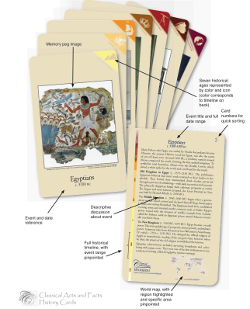Classical Conversations is primarily known for its group classes that are set up in many areas throughout the country and even overseas. Classical Conversations incorporates a classical approach to education that focuses on accumulation of concrete information in the early grades through repetition and memorization. Consequently, they teach history by first requiring students to learn essential facts regarding key historical events and people from around the world in a chronological sequence. To that end, students in the program learn these facts in Classical Conversations classes, reinforcing that learning by memorizing songs (set to popular tunes) that incorporate titles or descriptions of each key event or person.
Now, Classical Conversations has produced beautiful, laminated cards that help students learn, study, and review these historical facts. There are 161 cards altogether, but they are published in four sets of about 40 cards each. Sets are for the Ancient World, the Medieval World, the New World, and the Modern World. The Modern World set also includes cards on the U.S. Presidents. Aside from the Presidents cards, all the others are divided into seven time periods rather than the simpler four categories you might expect from titles of the packaged sets; these are the seven time periods used within Classical Conversations’ approach to teaching history.
The cards cover worldwide events and people, including biblical and religious events and people. However, the perspective is skewed a little toward a “western civilization” study as you would expect from a classical program. Cards begin with Creation and Adam and Eve rather than with cavemen. Dating presumes that man was created thousands of years ago rather than tens of thousands of years ago or more.
The cards themselves are of exceptionally high quality. They are laminated yet are thin and flexible—easy to handle. Their 5” x 8” size makes it easy for children to hold them without blocking out information. Printed in full color on both sides, they display an image on one side that illustrates the featured person, people, or event. This side of the card also has the title and date of the event or the name of the person. In the top right corner is a color coded symbol indicating to which of the seven time periods the event belongs.
On the reverse, cards have about two to three paragraphs of information on the topic—sometimes this is as much information as students would learn through a history textbook. A timeline running down the left side shows where in history the event fits. A small world map in the bottom right hand corner highlights where the event occurred. A number at the top right is handy for quickly organizing cards into chronological order.
While these cards are obviously useful for those in Classical Conversations groups, they should prove very useful for others who want their students to grasp key events in relation to one another through history. Once students have mastered the key events, they have a framework within which to associate other historical information they learn. Young students can begin by simply learning the names of the events in order, while older students should learn the rest of the information.
I mentioned that children in Classical Conversations learn these facts set to musical tunes. You can buy very inexpensive ($1.60 for each section or $8 for the entire song) downloadable mp3 files of the songs, so that your children can learn and remember the facts more easily. You can find ordering information for the song at: http://www.classicalconversationsbooks.com/clacfahitiso.html. I highly recommend that you at least try working with one of the small song files to see how well this method works with your children.








